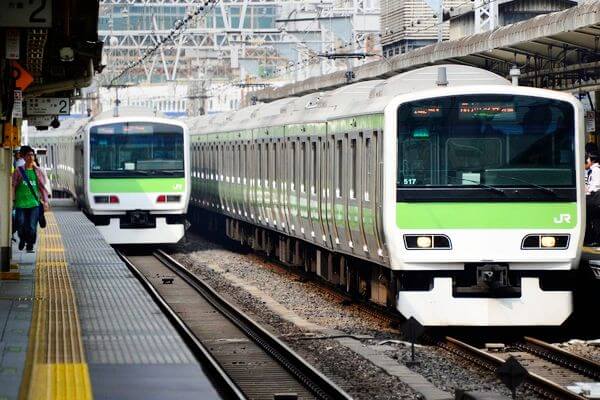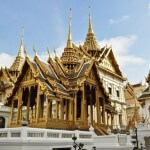Often times it is hard to find information concerning major tourist destinations that cover things for wheelchair users. This guide, the first in my new “Rolling Around” series, was created to answer that problem. This post will be all about one of my biggest dream destinations – Tokyo, Japan! Here, I will cover a few of the most accessible attractions and public transportation modes that are wheelchair accessible. Now, let’s start rolling around Tokyo!
Transportation
The train system in Tokyo is absolutely vital if you want to navigate the city. The system is intricate, however, all of the lines are color-coded and maps are usually available in your language. If you are an English speaker, there are usually a couple of people around the ticket booth who speak the language. That is always a nice bonus.
There are wheelchair accessible gates that you can simply roll up to and purchase your ticket. If you are alone, they will help push you through the entrance without asking most of the time. If you have any questions they are more than happy to answer them and can certainly get you pointed in the right direction. The train doors slide open for easy access. Simply roll in and roll out when your destination comes up. This is one of the better parts about traveling around in Tokyo.
If you travel by one of the streetcars or trams in the city then more than likely you will have adequate wheelchair access. The bigger tourist cities in Japan always have streetcars and trams that are accessible for wheelchair users. Accessibility only becomes an issue if you are traveling in rural or remote areas of Japan.
The buses in Tokyo are wheelchair accessible and more than accommodating. The bus stops are easy to find and are scattered throughout the city. Typically, the middle door of the bus will open for wheelchair users to enter and exit. The only drawback is scheduling. The bus system has no set schedule because the traffic varies so much in this action packed metropolis.
Attractions
Many people that visit Tokyo want to experience one of the Shinto or Buddhist temples. If you are wheelchair-bound, this can be pretty challenging. A lot of the traveling distance requires access via worn-out paths. These roads may be worn, but are able to be traversed in a wheelchair, though they might be a bit bumpy. However, on the temple grounds you will often encounter pebble roads which can make rolling downright miserable.
Therefore, before you start rolling down the road to serenity, do your homework. Ask around to make sure the temple you want to visit is wheelchair accessible. Otherwise, you might just have to gain your peace and serenity from a distance.

Sensoji is an ancient Buddhist temple located in Asakusa. It is Tokyo’s oldest temple and one of its most significant.
Any of the museums in Tokyo however, are extremely wheelchair accessible. Most of them have free wheelchairs available on the ground level if you need them. For example, this is the case at the Metropolitan Museum of Photography. Most of the museums also have ramps that you can use to access the different levels or, as in the Museum of Yebisu (Beer), you can use elevators to “hop” from one level to another, no pun intended. In all, there are about 25 museums in Tokyo so chances are you will not visit all of them while you are there. Yet, you can rest assured that the museums you choose will be extremely wheelchair friendly.
The gardens and parks of Tokyo such as Shinjuku Gyoen and National Garden and the Bamboo Forest of Kyoto are wheelchair accessible to a degree. Most of the time the path is easy to follow except for a few spots along the way where pebbles are strewn across. At those spots you can go off road to get back onto the trail or just push through the pebbles. The bamboo forest however gives a much easier ride. That is, until you come to the hills. If you feel up for a challenge, try seeing how many of those steep hills you can roll up. Even without making every hill though, the experience is still a worthwhile endeavor.
Beyond that, there are many amusement parks, arcades, and animal exhibits or zoos in and around Tokyo. Most all of them are extremely accessible with the exception of the amusement parks. Amusement parks do what they can to make the experience wheelchair friendly. However, since they are themed around rides, not all of the rides are wheelchair accessible. The trade-off is there are many places to eat and shop, and there are other attractions on site. However, as far as the arcades and zoos are concerned, wheelchair access is plentiful, making the spaces very easy to navigate. Be sure to pack plenty of water and snacks if you are going on a hot day!
Like any country, Tokyo has its fair share of accessible and non-accessible aspects, including many wheelchair accessible hotels. I usually have to get a bit creative when traveling somewhere new, but if you are determined enough then you can accomplish going almost anywhere. Writing this article made my desire to visit the land of the rising sun greater than ever before and I hope that it did the same for you.
Have you visited Tokyo? Do you want to?
*A Note from Curb Free with Cory Lee: This post includes affiliate links. When you click on a link, I may receive a small compensation, which will help this blog grow into a better resource for disabled travelers.











Tokyo looks incredible, I can’t wait to visit the bamboo forest and hopefully see the cherry blossoms in Spring! Thanks for sharing Cory!
Tokyo is my favorite travel destination, it’s absolutely amazing. There is so much to do and see, I really can’t recommend it enough. Great guide and pictures
Craig recently posted…The Best Fall Activities in New England
The Bamboo forest is iconic for Japan, and I’d love to see it when I make it out to Asia – so far it has only been Europe, Africa, and North America… I know I’m missing a lot and I’m that much psyched for it.
I have visited Japan before but it will be my first time visiting Tokyo next spring. It seems that the city is pretty accessible!
Chanel | Cultural Xplorer recently posted…16 Things to Do in Munich
Japan is high on my list but it will have to wait a bit due to the cost. My best friends went to Tokyo and other parts earlier this year and fell in love with it. Great to hear that the transit and museums are so wheelchair accessible.
sarah recently posted…Vancouver – A Few Of My Favorite Things
Japan is a country that I really want to visit and my boyfriend and I decided we are going to spend 3-4 weeks there for our honeymoon in a couple of years so I am already excited!
Katie @ The World on my Necklace recently posted…Stepping back in time to the Gold Rush days at Sovereign Hill
I’d love to get to Tokyo some day. I love the combination of modern city and ancient history. Glad it’s pretty accessible!
Amy recently posted…Finding cheap flights: Best resources
Awesome post Cory! And I’m really glad you’ve managed to find a way to see the places you have your heart set on. That bamboo forest looks beautiful!
Karyn @ Not Done Travelling recently posted…How To Escape The Crowds On Phi Phi Leh
Love love love Tokyo! The people are just the friendliest I have ever come across and I could honestly eat Japanese food all day everyday. I just wish it wasn’t so salty! This is a fantastic guide Cory and I imagine it will be very handy for those in a wheelchair considering visiting the mega city.
Jen Seligmann recently posted…30 Photos to Make You Want to Visit Floriade